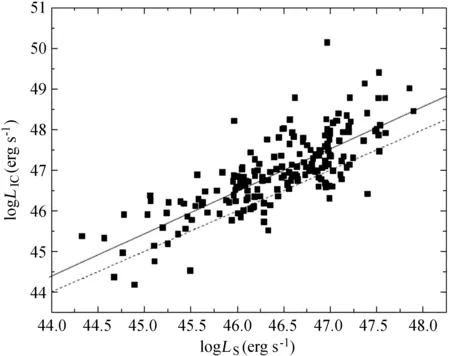Fermi平谱射电类星体外光子场的研究*
黄 霞,马 力,熊定荣,茶永娟,俞效龄,陈永云,龙光波,罗 丹,屠晶晶
(云南师范大学物理与电子信息学院,云南 昆明 650500)
Fermi平谱射电类星体外光子场的研究*
黄 霞,马 力,熊定荣,茶永娟,俞效龄,陈永云,龙光波,罗 丹,屠晶晶
(云南师范大学物理与电子信息学院,云南 昆明 650500)
基于外康普顿模型,通过对193个伽玛射线空间望远镜探测的平谱射电类星体的外光子场进行研究,结果表明:(1)逆康普顿散射峰值的光度和同步辐射峰值的光度之比LIC/LS与逆康普顿峰频率和同步峰频率之比νIC/νS呈负相关;(2)逆康普顿散射峰值的光度和同步辐射峰值的光度之间具有强的相关性,并且logLIC=1.05logLS-1.58;(3)对于大部分Fermi平谱射电类星体,逆康普顿散射峰值的光度大于同步辐射峰值的光度。这些结果说明平谱射电类星体的种子光子除了来自宽线区外,还可能来自其它区域,并且与喷流的运动和磁场以及外部光子的能量密度有关。
平谱射电类星体;光度;逆康普顿散射;外光子场;种子光子
耀变体(Blazar)具有快速光变、高偏振、非热连续辐射等物理性质。根据其弱发射线等值宽度(EW)不同,耀变体可分为蝎虎天体(BL Lac,EW<0.5 nm)和平谱射电类星体(FSRQ,EW>0.5 nm)[1]。为了解释耀变体伽玛射线的产生机制,研究者们提出了不同的物理过程,例如:同步自康普顿(SSC)过程[2];逆康普顿散射来自吸积盘的软光子过程[3-4];逆康普顿散射被周围的气体和尘埃散射的软光子或逆康普顿散射宽线区气体云产生的软光子过程[5-6];极端相对论性质子与软光子和重子相互作用过程[7-9]。
由于Fermi大面积望远镜(Fermi Large Area Telescope)具有高灵敏度,宽的探测能段,大视场等特性,到目前为止已经观测到数百颗耀变体[10]。在近期发表的Fermi二期伽玛射线源表中包含395个蝎虎天体,310个平谱射电类星体和157个不知道具体类型的耀变体[11]。由于平谱射电类星体的吸积率较大,高效的吸积流导致强的外光子场。一般认为,平谱射电类星体的伽玛射线辐射产生于外部康普顿散射过程[12-13]。文[14]利用均匀的外康普顿模型(种子光子来自宽线区)研究耀变体的高能辐射和外光子场的性质。本文基于外康普顿模型对Fermi平谱射电类星体的高能辐射和外光子场的性质进行研究。论文的第1部分阐述利用平谱射电类星体样本数据得到参数的过程;第2部分是结果;第3部分是讨论和结论。
1 样本和方法
文[15]从Fermi二期源表中选取了一批在静止坐标下有确定的同步辐射峰值频率、5 GHz流量密度和红移的 “干净” 样本,样本包括352个源(145个蝎虎天体,195个平谱射电类星体和12个不知道具体类型的耀变体),他们利用康普顿主导参数(逆康普顿散射峰值的光度与同步辐射峰值的光度之比)研究Fermi耀变体的序列。由于平谱射电类星体的吸积率较大,具有较强的外光子场,所以选取文[15]中的193个Fermi平谱射电类星体作为研究的样本(由于2FGLJ1033.9+6050和 2FGLJ2330.2+1107没有红移,因此将这两个源排除),并采用相对应的同步辐射峰值频率logνS、同步辐射峰值光度logLs和逆康普顿散射峰值的光度logLIC。
为了研究平谱射电类星体的高能辐射和外光子场的性质,需要得到逆康普顿散射峰值的频率νIC, 由文[16]的经验关系:
logνIC=-4.0Γγ+31.6,
(1)
得到νIC,伽玛射线光子谱指数Γγ从文[15]中得到。
用(1)式计算νIC,结果列在表1中。表1中:(1)列是Fermi源名称;(2)列是红移;(3)列是同步辐射峰值频率对数logνS;(4)列是同步辐射峰值光度对数logLS;(5)列是逆康普顿散射峰值光度对数logLIC;(6)列是逆康普顿散射频率对数logνIC;(7)列是逆康普顿散射峰值频率和同步辐射峰值频率之比的对数log(νIC/νS);(8)列是逆康普顿散射峰值光度和同步辐射峰值光度之比的对数log(LIC/LS)。

表1 平谱射电类星体样本

续 表

续 表

续 表

续 表
2 结 果
图1给出了样本的红移分布。从图1可以看出:样本的红移分布在0到3.2之间,红移平均值是1.5。该红移分布图和完整Fermi平谱射电类星体的红移分布一致[11],表明选取的样本是有代表性的Fermi样本。
图2给出了Fermi平谱射电类星体LIC/LS和νIC/νS的关系。利用一元线性回归分析方法,得到Fermi平谱射电类星体LIC/LS和νIC/νS之间满足下列经验关系:
log(LIC/LS)=-0.29log(νIC/νS)+3.09,
其中,相关系数r=-0.47;标准偏差SD=0.5;置信度P<0.0001。回归分析结果表明,Fermi平谱射电类星体LIC/LS和νIC/νS之间存在负相关性。

图1 红移分布图
图3给出了Fermi平谱射电类星体的逆康普顿散射峰值的光度和同步辐射峰值的光度的关系。利用一元线性回归分析方法,得到Fermi平谱射电类星体的逆康普顿散射峰值的光度和同步辐射峰值的光度的经验关系:
logLIC=1.05logLS-1.58,
其中,相关系数r=0.78;标准偏差SD=0.6;置信度P<0.0001。线性回归分析结果表明,逆康普顿散射峰值的光度和同步辐射峰值的光度之间具有强的相关性。从图3可以看出,对于大部分Fermi平谱射电类星体,逆康普顿散射峰值的光度大于同步辐射峰值的光度。

图2 逆康普顿散射峰值的光度和同步辐射峰值的光度之比(LIC/LS)与逆康普顿散射峰值的频率和同步辐射峰值的频率(νIC/νS)的关系图,黑线是线性回归拟合的结果

图3 逆康普顿散射峰值的光度和同步辐射峰值的光度的关系图,实线是线性回归的结果,虚线是逆康普顿散射峰值的光度等于同步辐射峰值的光度
3 讨论和结论
通过研究一个Fermi平谱射电类星体样本得到:(1)逆康普顿散射峰值的光度和同步辐射峰值的光度之比LIC/LS与逆康普顿散射峰值频率和同步辐射峰值频率之比νIC/νS呈负相关,并且log(LIC/LS)=-0.29log(νIC/νS)+3.09;(2)逆康普顿散射峰值的光度与同步辐射峰值的光度之间具有强的相关性,并且logLIC=1.05logLS-1.58;(3)对于大部分Fermi平谱射电类星体,逆康普顿散射峰值的光度大于同步辐射峰值的光度。
从结果可以得到逆康普顿散射峰值的光度和同步辐射峰值的光度之间具有很强的相关性,r=0.78。基于外康普顿模型研究平谱射电类星体的高能辐射和外光子场的性质,结合逆康普顿散射峰值和同步辐射峰值的频率得到逆康普顿散射峰值和同步辐射峰值的光度之比为

文[14]基于均匀的外部康普顿散射过程(种子光子来自宽线区),得到方程:
从上式可以得到:如果外光子场的能量密度Uext>0,LIC/LS和(νIC/νS)2之间应该有正的相关性,这和统计分析的结果是矛盾的,可能的原因是:(1)平谱射电类星体的种子光子除了来自宽线区外,还可能来自其它区域,例如喷流内部、尘埃环等[20-25]; (2)文[15]得到的数据是利用宽波段的谱指数得到同步峰的频率,利用5 GHz光度和同步峰频率得到同步辐射峰值的光度,利用Fermi谱外推得到高能峰的光度,利用伽玛光子谱指数得到高能峰的频率。通常,得到这些参数最好的方法是对准同时性多波段能谱进行拟合,因此这些近似的估算对结果可能会有影响。
在分析处理数据的过程中对一些参数的评估可能存在一定误差,因为有很多因素影响νS、νIC和对应的光度,要得到精确的误差很难。文[15]讨论了可能的误差来源:(1)射电、光学、X-射线,这可能对νS和νIC的确定有影响;(2)拟合能谱分布(Spectral Energy Distribution, SED)的函数不准确,可能也会引入误差;(3)伽玛射线的光度测量存在误差,可能会影响LIC的确定;(4)光变也会引入误差。
[1] Urry C M, Padovani P. Unified schemes for radio-loud active galactic nuclei [J]. Publications of the Astronomical Society of the Pacific, 1995, 107(715): 803-845.
[2] Maraschi L, Ghisellini G, Celotti A. A jet model for the gamma-ray emitting blazar 3C 279[J]. The Astrophysical Journal, 1992, 397(1): L5-L9.
[3] Dermer C D, Schlickeiser R, Mastichiadis A. High-energy gamma radiation from extragalactic radio sources [J]. Astronomy and Astrophysics, 1992, 256(2): 27-30.
[4] Zhang L, Cheng K S. Gamma-ray production through inverse Compton scattering with anisotropic photon field from accretion disk in AGNs [J]. The Astrophysical Journal, 1997, 488(1): 94-108.
[5] Sikora M, Begelman M C, Rees M J. Comptonization of diffuse ambient radiation by a relativistic jet: the source of gamma rays from blazars?[J]. The Astrophysical Journal, 1994, 421(1): 153-162.
[6] Xie G Z, Zhang Y H, Fan J H. The relation between gamma-ray and near-infrared radiation in gamma-ray-loud blazars[J]. The Astrophysical Journal, 1997, 477(1): 114-117.
[7] Mannheim K, Biermann P L. Gamma-ray flaring of 3C 279 - a proton-initiated cascade in the jet? [J]. Astronomy and Astrophysics, 1992, 253(2): 21-24.
[8] Mannheim K. The proton blazer[J]. Astronomy and Astrophysics, 1993, 269(1-2): 67-76.
[9] Cheng K S, Ding W K Y. On the gamma-ray emission from Markarian 421[J]. Astronomy and Astrophysics, 1994, 288(1): 97-102.
[10]Abdo A A, Ackermann M, Ajello M, et al. Bright active galactic nuclei source list from the first three months of the Fermi Large Area Telescope all-sky survey[J]. The Astrophysical Journal, 2009, 700(1): 597-622.
[11]Ackermann M, Ajello M, Allafort A, et al. The second catalog of active galactic nuclei detected by the Fermi Large Area Telescope[J]. The Astrophysical Journal, 2011, 743(2): 171-208.
[12]Cao X W, Bai J M. How many radio-loud quasars can be detected by the Gamma-Ray Large Area Space Telescope? [J]. The Astrophysical Journal, 2008, 673(2): L131- L134.
[13]Liu H T, Bai J M, Ma L. Absorption of 10 GeV-1 TeV gamma rays by radiation from the Broad-Line Region in 3C 279[J]. The Astrophysical Journal, 2008, 688(1): 148-158.
[14]Gao X Y, Wang J C, Zhou M. External photon fields in Fermi bright blazars[J]. Research in Astronomy and Astrophysics, 2011, 11(8): 902-908.
[15]Finke J D. Compton dominance and the blazar sequence[J]. The Astrophysical Journal, 2013, 763(2): 134-145.
[16]Abdo A A. Ackermann M, Agudo I, et al. The spectral energy distribution of Fermi bright blazars[J]. The Astrophysical Journal, 2010, 716(1): 30-70.
[17]Leismann T, Antón L, Aloy M A, et al. Relativistic MHD simulations of extragalactic jets[J]. Astronomy and Astrophysics, 2005, 436(2): 503-526.
[18]McKinney J C. General relativistic magnetohydrodynamic simulations of the jet formation and large-scale propagation from black hole accretion systems[J]. Monthly Notices of the Royal Astronomical Society, 2006, 368(4): 1561-1582.
[19]Keppens R, Meliani Z, van der Holst B, et al. Extragalactic jets with helical magnetic fields: relativistic MHD simulations[J]. Astronomy and Astrophysics, 2008, 486(3): 663-678.
[20]Ackermann M, Ajello M, Allafort A, et al. The radio/gamma-ray connection in active galactic nuclei in the era of the Fermi Large Area Telescope[J]. The Astrophysical Journal, 2011, 741(1): 30-95.
[21]Leon-Tavares J, Valtaoja E, Tornikoski M, et al. The connection between gamma-ray emission and millimeter flares in Fermi/LAT blazars [J]. Astronomy and Astrophysics, 2011, 532: 146-156.
[22]Linford J D, Taylor G B, Romani R W, et al. Contemporaneous VLBA 5GHz observations of Large Area Telescope-detected blazars [J]. The Astrophysical Journal, 2012, 744(2): 177-223.
[23]Nieppola E, Tornikoski M, Valtaoja E, et al. Correlation between Fermi/LAT gamma-ray and 37GHz radio properties of northern AGN averaged over 11 months [J]. Astronomy and Astrophysics, 2011, 535: 1-13.
[24]Ghirlanda G,Ghisellini G, Tavecchio F, et al. The radio-gamma-ray connection in Fermi blazars[J]. Monthly Notices of the Royal Astronomical Society, 2011, 413(2): 852-862.
[25]Kang Shiju, Chen Liang, Wu Qingwen. Constraints on the minimum electron Lorentz factor and matter content of jets for a sample of bright Fermi blazars [J]. The Astrophysical Journal Supplement, 2014, 215(1): 5-20.
A Study of External Photon Fields in Flat-Spectrum Radio Quasars Observed by the Fermi Large Area Telescope
Huang Xia, Ma Li, Xiong Dingrong, Cha Yongjuan, Yu Xiaoling, Chen Yongyun, Long Guangbo, Luo Dan, Tu Jingjing
(College of Physics and Electronics, Yunnan Normal University, Kunming 650500, China, Email:hxia0924@163.com)
Based on the model of External Compton (EC) photons, we have collected a sample of 193 Flat Spectrum Radio Quasars (FSRQs) observed by the Fermi Large Area Telescope and explored the properties of the external photon fields (as radiation seeds) in them. The results of our study are as follows. (1) There is an anti-correlation between (LIC/LS) and (νIC/νS) in our sampled FSRQs. Here, the (LIC/LS) is the ratio of the peak luminosity of inverse Compton scattering radiation to that of synchrotron radiation; the (νIC/νS) is the ratio of the peak frequency of inverse Compton scattering radiation to that of synchrotron radiation. (2) The peak luminosities of inverse Compton scattering radiation are strongly correlated with those of synchrotron radiation in the FSRQs. (3) In most FSRQs the peak luminosities of inverse Compton scattering radiation are above those of synchrotron radiation. The results show that in FSRQs photons as radiation seeds may be from broad-line regions as well as additional regions, and jet motions are related to the magnetic fields/external-photon energy densities.Key words: Flat-Spectrum Radio Quasars; Luminosity; Inverse Compton scattering radiation; External photon field; Photons as radiation seeds
国家自然科学基金 (11163007);国家自然科学基金 (U1231203) 资助.
2014-12-26;
2015-01-28
黄 霞,女,硕士. 研究方向:天体物理. Email: hxia0924@163 com
马 力,男,教授. 研究方向:天体物理. Email: mali@ynnu edu cn
P158
A
1672-7673(2015)04-0385-09
CN 53-1189/P ISSN 1672-7673

